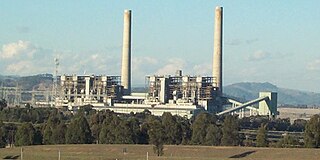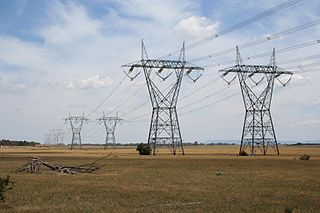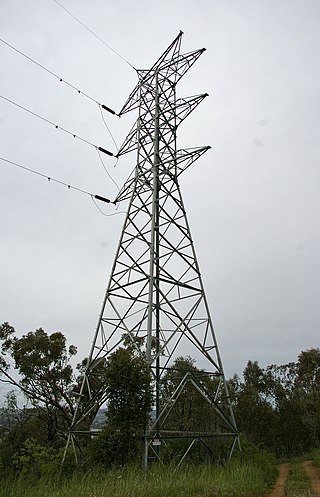| Company type | State government owned |
|---|---|
| Industry | Utility |
| Predecessor |
|
| Founded | 1 March 2011 |
| Headquarters | , Australia |
| Services |
|
| Owner | Government of New South Wales |
| Subsidiaries | Essential Water |
| Website | www |
Essential Energy is a state-owned electricity infrastructure company which owns, maintains and operates the electrical distribution networks for much of New South Wales, covering 95 percent of the state geography (and some neighbouring parts of Queensland). [1] It also owns the reticulated water network in Broken Hill through Essential Water, formerly Australian Inland Energy and Water. [2]
Essential Energy was formed from the previously state-owned energy business, Country Energy, when the retail division of the company, along with the Country Energy brand, was sold by the NSW Government in 2011 to Origin Energy.

There are many forms of transport in Australia. Australia is highly dependent on road transport. There are more than 300 airports with paved runways. Passenger rail transport includes widespread commuter networks in the major capital cities with more limited intercity and interstate networks. The Australian mining sector is reliant upon rail to transport its product to Australia's ports for export.

A public utility company is an organization that maintains the infrastructure for a public service. Public utilities are subject to forms of public control and regulation ranging from local community-based groups to statewide government monopolies.

Scottish Power Limited, trading as ScottishPower, is a vertically integrated energy company based in Glasgow, Scotland. It is a subsidiary of Spanish utility firm Iberdrola.

The Channel Country is a region of outback Australia mostly in the state of Queensland but also in parts of South Australia, Northern Territory and New South Wales. The name comes from the numerous intertwined rivulets that cross the region, which cover 150,000 km². The Channel Country is over the Cooper and Eromanga geological basins and the Lake Eyre Basin drainage basin. Further to the east is the less arid Maranoa district.
RWE AG is a German multinational energy company headquartered in Essen. It generates and trades electricity in the Asia-Pacific region, Europe and the United States.

The Stephens Creek Dam is an earth-filled embankment dam built on a rock foundation with an uncontrolled spillway across the Stephens Creek, located in the Far West region of New South Wales, Australia. The principal purpose of the dam is to supply potable water for the town of Broken Hill. The impounded 2,000-megalitre reservoir is called Stephens Creek Reservoir.
National Grid plc is a British multinational electricity and gas utility company headquartered in London, England. Its principal activities are in the United Kingdom, where it owns and operates electricity and natural gas transmission networks, and in the Northeastern United States, where as well as operating transmission networks, the company produces and supplies electricity and gas, providing both to customers in New York and Massachusetts.
Icon Water Limited, trading principally as Icon Water, is a water and wastewater public utility that is an Australian Capital Territory-owned corporation. The company provides drinking water and wastewater services to the ACT. Icon Water is also a 50% owner of ActewAGL, a multi-utility provider of electricity and gas services in the ACT and south-east New South Wales. Icon Water Limited is also the owner of Bendora Dam, Corin Dam, Cotter Dam and Googong Dam in New South Wales. Water is gravity fed to Canberra via the Bendora Gravity Main and pumped from Googong Dam. Icon Water operates, and maintains 50 service reservoirs, 25 pump stations, 2 water treatment plants, 27 sewage pumping stations, 4 sewage treatments plants, over 3,400 km of sewer pipelines and over 3,400 km of water pipelines.

Country Energy, an Australian energy retail subsidiary of Origin Energy, provides natural gas and electricity to retail customers in New South Wales, Victoria, Queensland, South Australia and the Australian Capital Territory.. Since its establishment in 2001 and until 28 February 2011, Country Energy was owned by the Government of New South Wales.

Origin Energy Ltd is an ASX listed public company with headquarters in Sydney. It is a major integrated electricity generator, and electricity and natural gas retailer. It operates Eraring Power Station, Australia’s largest coal-fired power station, in New South Wales, which it plans to close in 2025. As of 2024, it plans to "minimise" its ownership of wind and solar power, to boost investor returns. It owns 20% of Octopus Energy, a UK renewable energy retailer.

Eraring Power Station is a coal-fired power station consisting of four 720 MW Toshiba steam-driven turbo-alternators for a combined capacity of 2,880 MW. The station is located near the township of Dora Creek, on the western shore of Lake Macquarie, New South Wales, Australia and is owned and operated by Origin Energy. It is Australia's largest power station. The plant has two smokestacks rising 200 m (656 ft) in height. It was scheduled for closure by mid-2025, after a failed attempt to sell the loss making power station back to the state government. The New South Wales Government in May 2024 extended the operational life of Eraring to August 2027.

Liddell Power Station is a decommissioned coal-fired thermal power station that had four 500 megawatts (670,000 hp) EE steam-driven turbine alternators, providing a combined electrical capacity of 2,000 megawatts (2,700,000 hp).

AGL Energy Ltd is an Australian listed public company involved in both the generation and retailing of electricity and gas for residential and commercial use. It is one of the "big three" retailers in the National Electricity Market. AGL is Australia's largest electricity generator, and the nation's largest carbon emitter. In 2022, 83% of its energy came from burning coal.

Energy in Victoria, Australia is generated using a number of fuels or technologies, including coal, natural gas and renewable energy sources. Brown coal, historically, was the main primary energy source for the generation of electricity in the state, accounting for about 85% of electricity generation in 2008. The amount of coal-fired power has decreased significantly with the closure in 2017 of the Hazelwood power station which supplied around 20% of Victoria's electricity, and to a lesser extent with the exit of Anglesea power station in 2015. Brown coal is one of the largest contributors to Australia's total domestic greenhouse gas emissions and a source of controversy for the country. Australia is one of the highest polluters of greenhouse gas per capita in the world.

The Electricity Commission of New South Wales, sometimes called Elcom, was a statutory authority responsible for electricity generation and its bulk transmission throughout New South Wales, Australia. The commission was established on 22 May 1950 by the Electricity Commission Act 1950 to take control of power generation in the State. The commission acquired the power stations and main transmission lines of the four major supply authorities: Southern Electricity Supply, Sydney County Council, the Department of Railways and the Electric Light and Power Supply Corporation Ltd, also known as the Balmain Electric Light Company, the owner and operator of Balmain Power Station. The commission was responsible for the centralised co-ordination of electricity generation and transmission in the State, and some local councils continued to be distributors of electricity only.

Lumo Energy is an Australian energy retailer operating in Victoria and South Australia, which has been wholly owned by Snowy Hydro since 2014. The business offers electricity and gas packages in Victoria and South Australia. As of October 2017, the business had almost 500,000 customers and a workforce of just under 500 people.

Ausgrid is an electricity distribution company which owns, maintains and operates the electrical networks supplying 1.8 million customers servicing more than 4 million people in Sydney, the Central Coast and Hunter regions of New South Wales, Australia. It was formed in 2011 from the previously state-owned energy retailer/distributor, EnergyAustralia, when the retail division of the company, along with the EnergyAustralia brand, was sold by the Government of New South Wales, and the remainder renamed Ausgrid.
Macquarie Generation is an electricity generation company in New South Wales, Australia, owned by AGL Energy, and has a portfolio of generating sites using predominantly thermal coal power. The company now trades as AGL Macquarie and generates electricity for sale under contract.
Australian Gas Networks Limited, formerly Envestra Limited, is an Australian energy company that operates natural gas transmission pipelines and distribution networks in South Australia, Victoria, Queensland, New South Wales, and the Northern Territory. The company owns distribution systems in a number of towns and metropolitan areas including Adelaide, Brisbane, Melbourne, Rockhampton, Albury, Alice Springs, Bundaberg and Whyalla. It outsources the operation and management of the assets to the APA Group.
In Australia the predominant term used for SOEs is government business enterprise (GBE). Various Australian states also have GBEs, especially with respect to the provision of water and sewerage, and many state-based GBEs were privatized in some states during the last decade of the twentieth century. Former Commonwealth SOEs include Telstra, established in the 1970s as Telecom Australia. Telstra, now Australia's largest telecommunications company, was privatised in 1997 by the Howard government. As of June 2010 Telstra owned a majority of the copper wire infrastructure in Australia and is pending sale to its former parent, the Australian government, for a non-binding amount of 11 billion Australian dollars, as ducts in the copper wire tunnels are needed to install the fibre optic cable. The Commonwealth Bank, as its name indicates, was also founded as public company before later being privatized.